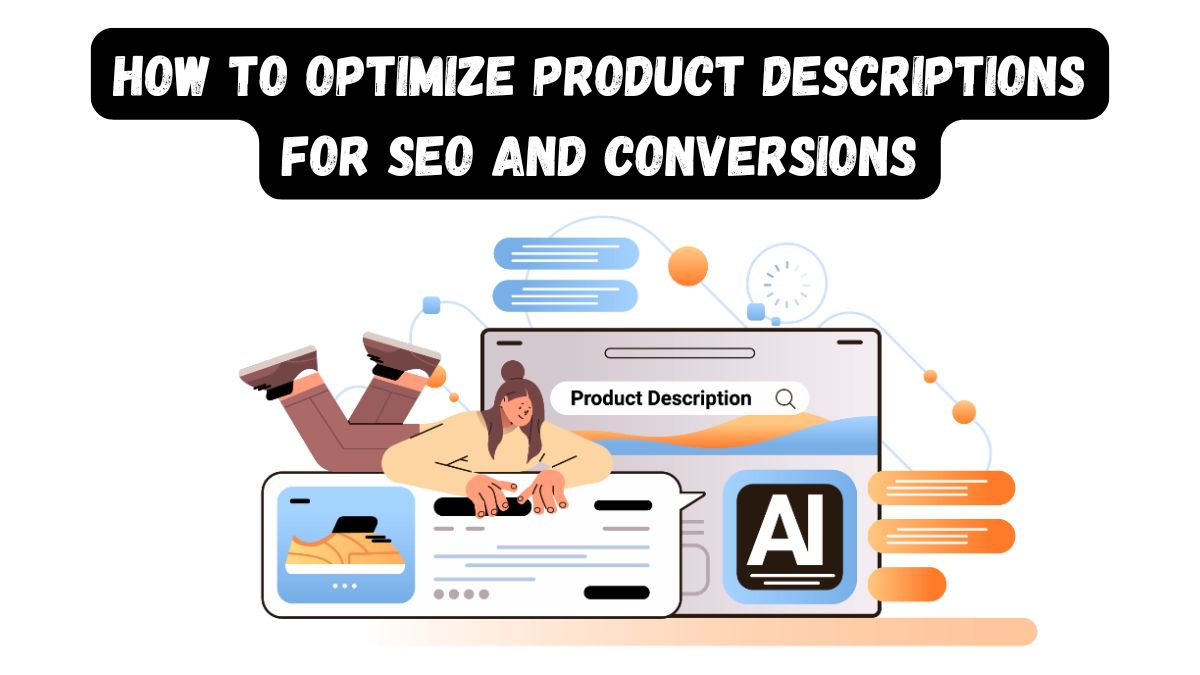
In the competitive world of e-commerce, your product descriptions can make or break your success. A good product description does more than just describe your product. It’s a magnet for search engine traffic. It also persuades visitors to become paying customers. Using SEO best practices with great copywriting boosts your visibility and sales. It makes your descriptions do two jobs.
This guide will explore proven ways to optimize product descriptions for SEO and conversions. It will help you stay ahead in the digital marketplace.
Why Optimized Product Descriptions Matter
Product descriptions serve as the voice of your brand and the gateway to conversions. Here’s why they are essential:
1. SEO Benefits
Search engines use the content on your product pages to understand what you’re selling and rank your page accordingly. Optimized descriptions:
-
Increase organic traffic.
-
Improve your chances of appearing in featured snippets.
-
Help your website rank for relevant, high-intent keywords.
2. Conversion Benefits
Good descriptions speak to the customer’s needs. They address pain points and show your product’s value. They:
-
Build trust and credibility.
-
Enhance the user experience.
-
Persuade customers to make informed purchasing decisions.
Key Strategies for Optimizing Product Descriptions
1. Conduct Keyword Research
Before writing or revising your product descriptions, find your audience’s keywords. Use tools like:
-
Google Keyword Planner
-
Ahrefs
-
SEMrush
Focus on:
-
Primary keywords: The main terms directly related to your product.
-
Long-tail keywords: Phrases with lower competition but high purchase intent, e.g., “best eco-friendly water bottle for hiking.”
Incorporate these keywords naturally into your descriptions, ensuring they don’t disrupt the flow of your copy.
2. Write for Your Audience
Your product descriptions should speak directly to your ideal customer. Understand their needs, preferences, and concerns by:
-
Creating buyer personas.
-
Analyzing customer reviews and feedback.
-
Addressing common questions or objections.
For instance, if you’re selling a laptop to students, highlight portability, battery life, and affordability.
3. Focus on Benefits Over Features
While listing features is important, emphasizing benefits makes your product more relatable. For every feature, explain how it solves a problem or improves the customer’s life.
Example:
-
Feature: “Comes with a 12-hour battery life.”
-
Benefit: “Stay productive all day without needing to recharge.”
4. Use Engaging and Concise Language
Write clear and compelling descriptions that keep the reader’s attention. Avoid overly technical jargon unless your target audience is highly specialized.
Tips:
-
Use active voice: “Transform your mornings with this energy-boosting coffee maker.”
-
Keep sentences short and impactful.
-
Avoid fluff or redundant phrases.
5. Optimize for Search Engines
To enhance the SEO of your product descriptions:
-
Include Keywords Strategically: Use them in titles, meta descriptions, and throughout the body text, but avoid keyword stuffing.
-
Structure Content with Headers: Use subheadings to improve readability and SEO rankings.
-
Use Alt Text for Images: Describe product images using keywords to boost image SEO.
6. Highlight Social Proof
Add testimonials, ratings, and reviews to your product descriptions. They build trust and credibility.
Example:
-
“Loved by over 10,000 customers for its durability and comfort.”
-
“Rated 4.9/5 by outdoor enthusiasts worldwide.”
7. Leverage Sensory Words
Paint a vivid picture with words that appeal to the senses. This helps customers imagine the experience of owning your product.
Example: Instead of saying, “Soft fabric,” say, “Luxuriously soft fabric that feels like a gentle embrace.”
8. Include a Clear Call-to-Action (CTA)
Encourage customers to take action with persuasive CTAs such as:
-
“Add to Cart Now for Free Shipping!”
-
“Order Today and Experience the Difference.”
9. Use Structured Data Markup
Implement schema markup on your product pages to improve how your listings appear in search engine results. Features like pricing, availability, and ratings can make your product stand out.
10. Optimize for Mobile Users
With the majority of online shoppers using mobile devices, ensure your product descriptions:
-
Are concise and scannable.
-
Use bullet points and short paragraphs.
-
Load quickly on mobile platforms.
11. Regularly Update Your Descriptions
SEO is an ongoing process. Refresh your product descriptions periodically to:
-
Incorporate new keywords.
-
Update outdated features or benefits.
-
Reflect seasonal or promotional changes.
Example of an Optimized Product Description
Product: Stainless Steel Water Bottle
“Stay hydrated and eco-friendly with our 32 oz Stainless Steel Water Bottle. This bottle is for the modern adventurer. It has a leak-proof cap and double-wall insulation. They keep drinks cold for 24 hours and hot for 12. Its lightweight design and durable build make it perfect for the gym or the great outdoors.
Rated 4.8/5 by thousands of happy customers, it’s time to ditch single-use plastics and upgrade to sustainable hydration.
Order now and enjoy free shipping on orders over $50!”
Common Mistakes to Avoid
1. Keyword Stuffing
Keywords are essential. But, overloading your text with them can hurt readability and SEO.
2. Ignoring User Intent
Understand whether your customers are looking for information, comparing products, or ready to buy. Tailor your descriptions accordingly.
3. Using Duplicate Content
Avoid copying manufacturer descriptions. Unique, original content performs better in search rankings.
Final Thoughts
To boost your e-commerce performance, optimize your product descriptions for SEO and conversions. Use keyword research, customer-focused copywriting, and technical optimization. You can then create descriptions that rank higher, attract more visitors, and drive sales.
Start using these strategies today. Your product pages will then become powerful tools for growing your online business.




